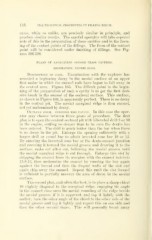Page 332 - My FlipBook
P. 332
148 THE TECHNICAL PROCEDUEES IN FILLING TEETH.
eases, while so unlike, are precisely similar in principle, and
produce similar results. The careful operator will take especial
note of this in the preparation of these cavities and in the form-
ing of the contact points of the fillings. The form of the contact
point will be considered under finishing of fillings. See Fig-
ures 396-398.
PLANS OF EXCAVATING SECOND CLASS CAVITIES.
ILLDSTBATIONS : FIGURES 165-186.
Description of case. Examination with the explorer has
revealed a beginning decay in the mesial surface of an upper
first molar in which the enamel rods have begun to fall away in
the central area. Figure 165. The difficult point in the begin-
ning of the preparation of such a cavity is to get the first deci-
sive break in the enamel of the occlusal surface. This surface,
as shown in Figure 166, is apparently perfect. There is no decay
in the central pit. The mesial marginal ridge is firm enamel,
not yet undermined by decay.
Outline form, opening the CA\aTY. In this case the ojier-
ator may choose between three plans of procedure. The first
plan is to open the central occlusal x^it with bibeveled drill 8 or 10
in the engine, cutting no deeper than to be sure the dentin has
been entered. The drill is much better than the bur when there
is no decay in the pit. Enlarge the opening sufficiently with a
larger drill or I'ound bur to admit inverted cone bur 10 or 12.
By entering the inverted cone bur at the dento-enamel junction
and pressing it toward the mesial groove and drawing it to the
surface, make cut after cut, following the mesial groove until
the mesial marginal ridge is cut through. Enlarge this slot by
chipping the enamel from its margins with the enamel hatchets
] 5-8-12, then undermine the enamel by running the bur again
against the buccal and then the lingual walls of the slot and
again chip away the enamel. Eepeat this until the slot formed
is sufficient to partiallj'^ uncover the area of decay in the mesial
surface.
The second plan, and often the best, is to place a sharp chisel
]0 slightly diagonal to the marginal ridge, engaging its angle
in the enamel close onto the mesial rounding of the ridge beside
the mesial groove, if it is apparent, and tap it lightly with the
mallot; turn the other angle of the chisel to the other side of the
mesial groove and taj) it lightly and repeat this on one side and
then the other several times. This will generally break away


